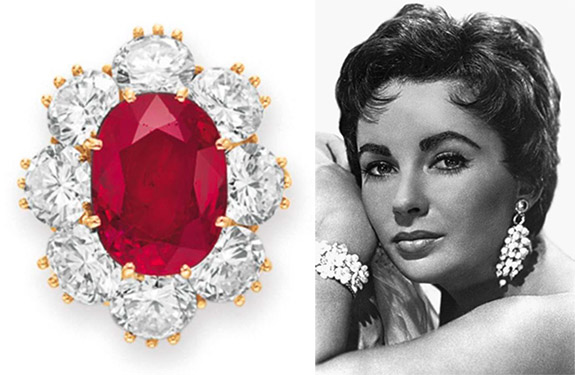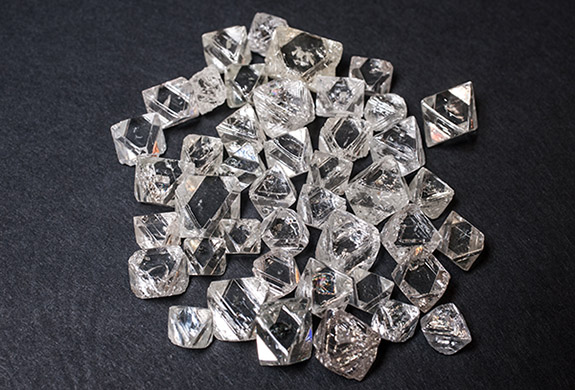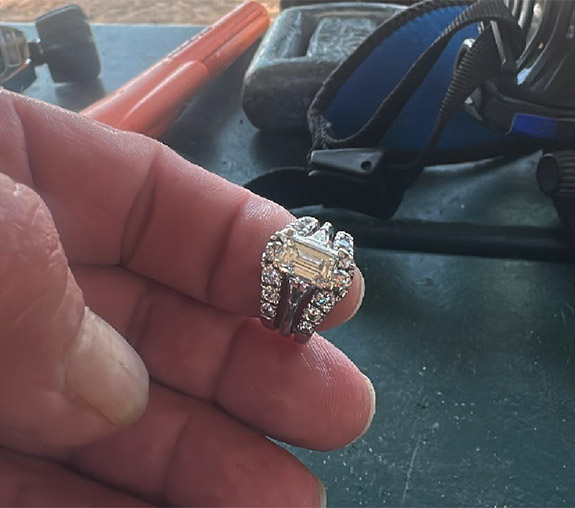
Citi Report: Jewelry Shines as US Luxury Shoppers Shift Spending Priorities
Amid a broader slowdown in US luxury spending, fine jewelry has emerged as a glimmering standout, according to a new report from Citigroup. Based on
If you’re planning a trip to the Land Down Under in 2024, be sure to see the “Pharaoh” exhibition at the National Gallery of Victoria (NGV), where more than 500 objects celebrating 3,000 years of ancient Egyptian jewelry, art and visual culture will be on display.

The huge collection will be on loan from The British Museum, which has amassed one of the most exceptional collections of ancient Egyptian objects in the world. It’s the largest international loan the London institution has ever undertaken.
Running from June 14 through October 6, the landmark presentation will unpack the phenomenon of pharaoh, those all-powerful kings who claimed a divine origin.

“What really sets our show apart is a focus on the artistic aspects of these works and the sheer beauty and skill of the crafting of these works,” said Amanda Dunsmore, NGV’s senior curator, international decorative arts and antiquities. “Ancient Egyptian sculptors were absolute masters of their craft.”
Among the 500 works are a wide array of exquisitely crafted gold jewelry, monumental sculpture, architecture, temple statuary, papyri (documents), coffins and a rich array of funerary objects.

The pharaohs presented an idealized image of themselves as invincible warriors and fervent worshippers of the gods. This is evident from the imagery on rings, bracelets and personal treasures, to the statues and monuments of colossal scale. Among the largest items is a 1.5-ton, 4-foot-wide fist of Ramses II.

The exhibition will be divided into seven thematic sections that explore the pharaoh’s roles and duties, including as the high priest officiating in temples, the head of the country’s administration, the leader of the army and the head of the royal family. The pharaohs were responsible for protecting Egypt against its enemies and ensuring universal order. They ruled both Upper and Lower Egypt from the 1st Dynasty (c. 3000 BCE) until the Roman conquest in 30 BCE.
Credits: Images courtesy of The Trustees of the British Museum.

Amid a broader slowdown in US luxury spending, fine jewelry has emerged as a glimmering standout, according to a new report from Citigroup. Based on

In celebration of July’s birthstone, we look back at one of the most iconic ruby jewels ever to hit the auction block: Hollywood icon Elizabeth

Russia and Botswana once again led the world in rough diamond production in 2024, according to newly released statistics from the Kimberley Process Certification Scheme.

A cherished 115-year-old wedding ring thought to be lost forever in a Texas lake has been miraculously recovered — thanks to the relentless efforts of






✨ Looking to sell or trade your jewelry? Look no further! ✨ At Elliott's Jewelers in Huntsville, TX, we buy and accept jewelry in trade every day, no matter where it was purchased.
Learn More.... www.elliottsjewelers.com/sell-your-jewelry/
We know that selling your jewelry can be an emotional journey, which is why we offer professional, personalized service to make the process as smooth as possible. Our team of experienced buyers and restoration specialists is dedicated to providing you with the best trade-in, upgrade, and cash-out options in the Huntsville-Walker County area.
📅 We are now taking appointments for the week starting July 7 through July 12.
We operate by appointment six days a week. Ready to get started? Schedule your visit today by going to our website: Learn More.... www.elliottsjewelers.com/sell-your-jewelry/
#ElliottsJewelers #HuntsvilleTX #JewelryTrade #SellYourJewelry #UpgradeYourJewelry #CashOut #JewelryExperts #PersonalizedService #EmotionalJourney #huntsvillewalkercounty ... See MoreSee Less
Book Travel
Precision Jewelry Buying in Huntsville, TX
www.elliottsjewelers.com
Unleash the true value of your vintage jewelry and find fabulous pre-owned gems at Elliott's Jewelers in Huntsville, TX.0 CommentsComment on Facebook
We are taking appointments at www.elliottsjewelers.com/book-an-appointment/ . ... See MoreSee Less
0 CommentsComment on Facebook
Celebrate Your Everlasting Love with Elliott's Jewelers!
Mark another year of cherished memories with our breathtaking Anniversary Ring, exclusively at Elliott's Jewelers in Huntsville, TX.
This exquisite ring features five natural bezel-set pear-shaped diamonds, meticulously crafted in 14kt yellow gold. With a remarkable 1.19 carats total weight of dazzling diamonds, this piece is a true testament to enduring love and sophisticated style.
Imagine the sparkle on her hand, a symbol of your unique journey together. This isn't just a ring; it's a future heirloom, a radiant reminder of your commitment.
Ready to see this stunning anniversary ring in person? We invite you to schedule a private viewing at your convenience.
Click here to book your appointment: www.elliottsjewlers.com/book-an-appointment
#ElliottsJewelers #AnniversaryRing #DiamondRing #PearShapedDiamonds #YellowGold #HuntsvilleTX #FineJewelry #CelebrateLove #TimelessTreasure
#TimelessTreasures #timelesstreasuresfabrics ... See MoreSee Less
Shop Now
0 CommentsComment on Facebook
Make a Statement with This Dazzling Orange-Yellow Diamond Engagement Ring! 🧡💛
Imagine her reaction when you present this one-of-a-kind Ladies Fancy Orange-Yellow Diamond Engagement Ring from Elliott's Jewelers!
This stunning ring features a vibrant 1.05 carat Orange-Yellow Radiant Cut center diamond, with SI1 clarity, that radiates warmth and brilliance. Complementing this magnificent center stone are 0.20 total weight Trillion side diamonds, adding an exquisite touch of sparkle. All set in elegant 14k White Gold, this ring is truly a masterpiece.
It's more than just a ring; it's a symbol of your unique love story.
Ready to make her dreams come true? Visit Elliott's Jewelers in Huntsville, TX, to see this breathtaking ring in person! Make an appointment at www.elliottsjewelers.com/book-an-appointment/
#OrangeYellowDiamond #EngagementRing #FancyDiamond #RadiantCut #DiamondRing #UniqueEngagementRing #HuntsvilleJeweler #ElliottsJewelers #SayYes #SheWillLoveIt #14kWhiteGold
#14kwhitegold ... See MoreSee Less
0 CommentsComment on Facebook
🌟 Protect Your Precious Jewelry with Confidence! 🌟
Ensure your cherished pieces are safeguarded against life's surprises. With our comprehensive jewelry insurance, your items will be repaired or replaced to their original kind and quality, giving you peace of mind.
Ready for a professional appraisal? Experience our six-step process designed for your convenience and satisfaction, led by owner Elliott Herzlich. Discover how easy it is to protect your investment!
Learn more here: [Elliott's Appraisal Services](www.elliottsjewelers.com/appraisal-services/)
#JewelryInsurance #JewelryAppraisal #ElliottsJewelers #ProtectYourInvestment #LuxuryJewelry #JewelryCare ... See MoreSee Less
Act Now: Get It Insured
www.jewelersmutual.com
Dedicated Jewelry Insurance Wear your jewelry worry-free with insurance from Jewelers Mutual, trusted for over 110 years. CHECK YOUR RATE ReviewsWhat's CoveredCostHow It WorksFAQs What Types of Jewelr...0 CommentsComment on Facebook
We are taking appointments at www.elliottsjewelers.com/book-an-appointment/ . ... See MoreSee Less
2 CommentsComment on Facebook
The Heart of a Personal Jeweler -- Elliott's Jewelers, Huntsville, TX
Want to learn more about Elliott's Jewelers?
Check out our story in Voyage Houston magazine! voyagehouston.com/.../check-out-elliott-herzlichs...
At Elliott’s Jewelers, clients aren’t just customers—they’re relationships built for life. With a blend of old-world craftsmanship, new-world sensibility, and unwavering integrity, Elliott has crafted something rare in modern retail: a business that prioritizes people above all else.
To book a private consultation or learn more about Elliott’s Jewelers, visit www.elliottsjewelers.com. ... See MoreSee Less
Learn More
0 CommentsComment on Facebook
✨ Why Choose a Diamond from Elliott’s Jewelers? ✨
A natural diamond is more than a purchase; it’s a timeless symbol of your love story, your shared memories, and the beautiful future you envision together. 💍❤️
At Elliott’s Jewelers, we offer a personal touch that sets us apart. When you choose your diamond with us, you're not just buying a gem; you're creating an experience. Our trusted jewelers will be by your side, guiding you every step of the way, ensuring you find the perfect diamond that resonates with your unique love.
Don't leave one of life's most precious moments to chance. Embrace the luxury of personalized service and make a confident choice that reflects your heart.
💖 Schedule your private consultation today, and let Elliott help you discover the diamond that feels like it was made just for you.
👉 www.elliottsjewelers.com/book-an-appointment
See available diamonds here: www.elliottsjewelers.com/diamonds-with-grading-report/
#ElliottsJewelers #DiamondLove #EngagementRing #LoveStory #ForeverStartsHere #PersonalJeweler #TimelessBeauty ... See MoreSee Less
Shop Now
Elliott's Jewelers, Huntsville TX Favorite Jeweler
www.elliottsjewelers.com
I get to create beautiful, memorable and emotional jewelry for customers who become lifelong friends. Call me to learn more.0 CommentsComment on Facebook
### Discover the Art of Custom Engagement Rings at Elliott’s Jewelers. Learn more about this ring and others at
www.elliottsjewelers.com/shop
✨ The beauty of a custom engagement ring lies in the intricate details—and in the journey of collaborating with a personal jeweler who truly understands your lifestyle and values. At Elliott’s Jewelers, we dedicate ourselves to bringing your vision to life, crafting a ring that's uniquely yours. 💍Elliott's Jewelers only offers genuine, natural, mined diamonds
📞 Call Elliott's Jewelers today at (936) 661-5363 or book an appointment online—available 6 days a week! www.elliottsjewelers.com/book-an-appointment/
🛍️ Browse our stunning collections online: www.elliottsjewelers.com/shop/
#CustomJewelry #EngagementRing #ElliottsJewelers #JewelryDesign #Personalized #Craftsmanship #Love #Engagement #JewelryShopping #UniqueDesigns ... See MoreSee Less
Call Now
2 CommentsComment on Facebook
✨ Your Jewelry Has an Irreplaceable Story to Tell ✨
The jewelry you’ve inherited is more than just exquisite; it's a treasured chapter of your family's legacy, a timeless piece that can be passed down through generations.
Every ring, bracelet, and pendant embodies the love, memories, and milestones that have shaped your family's journey. When you choose Elliott’s Jewelers, you’re not only preserving jewelry—you’re honoring the deep-rooted connections that bind your family together.
At Elliott's, we provide a comprehensive range of services to restore and protect your beloved heirlooms, including:
💍 Ring resizing
💎 Stone replacement
🔩 Prong repair & retipping
🔗 Chain & clasp repairs
✨ Professional cleaning & polishing
🔄 Full restorations
🎨 Custom redesigns, honoring the original while crafting something uniquely new.
Every repair is conducted with the same love and attention that your family deserves. Together, we’ll breathe new life into your cherished pieces, allowing you to wear them with pride and continue their story for many more years to come.
📅 Schedule your repair appointment with Elliott today, and let’s celebrate your family’s extraordinary legacy! Schedule your appointment here at www.elliottsjewelers.com/book-an-appointment/ ... See MoreSee Less
Book Travel
0 CommentsComment on Facebook
## Celebrate Your Everlasting Love with a Natural Diamond Ring from Elliott's Jewelers
Special moments deserve a ring as meaningful as the love they represent. At Elliott's Jewelers, we believe your unique story deserves to be told through the timeless brilliance of a **natural, earth-mined diamond**. Each diamond, forged deep within the earth, carries a history as rich and profound as the love you share.
We're here for every "yes," every happy tear, and every milestone yet to come. Let us help you create a ring that beautifully encapsulates your love and memories for a lifetime. Our commitment to exceptional quality and personalized service ensures your journey with us is as special as the love you're celebrating.
**Ready to find the perfect symbol of your devotion?**
* **Call Elliott's Jewelers today at (936) 661-5363** to speak with one of our diamond experts.
* **Book your personal appointment online:** We're available 6 days a week to assist you! Visit our booking page here: www.elliottsjewelers.com/book-an-appointment/
* **Browse our exquisite collection online:** --- www.elliottsjewelers.com/diamonds-with-grading-report/
Let's create a ring that will be cherished for generations. ... See MoreSee Less
Learn More
0 CommentsComment on Facebook
✨ Your Jewelry Has an Irreplaceable Story to Tell ✨
The jewelry you’ve inherited is more than just exquisite; it's a treasured chapter of your family's legacy, a timeless piece that can be passed down through generations. Every ring, bracelet, and pendant embodies the love, memories, and milestones that have shaped your family's journey. When you choose Elliott’s Jewelers, you’re not only preserving jewelry—you’re honoring the deep-rooted connections that bind your family together.
At Elliott's, we provide a comprehensive range of services to restore and protect your beloved heirlooms, including:
💍 Ring resizing
💎 Stone replacement
🔩 Prong repair & retipping
🔗 Chain & clasp repairs
✨ Professional cleaning & polishing
🔄 Full restorations
🎨 Custom redesigns, honoring the original while crafting something uniquely new
Every repair is conducted with the same love and attention that your family deserves. Together, we’ll breathe new life into your cherished pieces, allowing you to wear them with pride and continue their story for many more years to come.
📅 Schedule your repair appointment with Elliott today, and let’s celebrate your family’s extraordinary legacy! Schedule your appointment here at www.elliottsjewelers.com/book-an-appointment/ ... See MoreSee Less
Book Travel
0 CommentsComment on Facebook